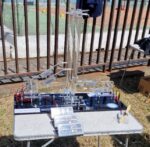


Sustainability Festival
On 23rd May 2023, between 10:00 and 19:00, in one of the main parks of the city of Messina, Villa Dante, the Sustainability Festival took place, organized by AMAM SpA, Messina Social City, Messinaservizi Bene Comune, ATM SpA and the Regional School Office. The...
Mednight Challenge Italia – MEDITERRANEAN SEA
On 5th May 2023 the online event “Mednight Challenge Italia – MEDITERRANEAN SEA” was held.The webinar, aimed at secondary school students, was conducted by three pairs of researchers from the University of Messina, who developed topics related to the...
Student week – “Archimede” High School – Palomba & Briguglio
On 5th April 2023, Giulia Palomba and Giovanni Briguglio participated in the Student Week, organized at the Archimede High School in Messina, with a contribution entitled ” Messina Energy Boat Team competing in Monaco Energy Boat Challenge (MEBC) 2023″....
Join the 2023 STEM Discovery Campaign, a joint international initiative organised by Scientix that invites educators, projects, organisations, libraries, schools, universities, youth clubs and all the interested stakeholders across Europe and the world to celebrate...













